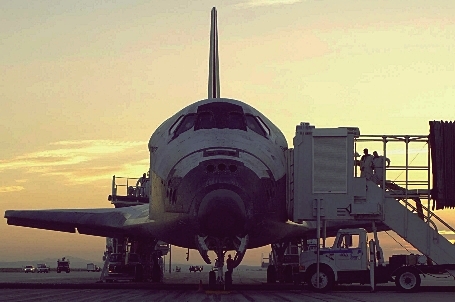
 Shuttle Discovery At the Edwards AFB After the STS-114 Mission.
The sun is rising on the runway at the Edwards AFB, California. Shuttle Discovery stands there, after a safe landing on August 9th, 2005 at 8:11 a.m. EDT. Shuttle Discovery was the orbiter for the STS-114 mission, the 'Return to Flight Mission', that is the first Space Shuttle flight to take place after the lull in the program due to the dramatic loss of shuttle Columbia, in February 2003. The Space Shuttle usually lands at the Shuttle Landing Facility (SLF), in the Kennedy Space Center, Florida, as two other runways are at its disposal, one at the Edwards Air Force Base, Calif., and the other at the White Sands Space Harbor, New Mexico. All Shuttle landings were initially conducted at the Edwards AFB, as the first landing at KSC took place in 1984. Today, it's Kennedy which is considered the prime landing site. Due to weather conditions, the STS-114's landing, after a 14-day sojourn at the International Space Station (ISS), had to be delayed by one day, then diverted to Edwards AFB. The Space Shuttle can't land in rainy weather as the weather-resistant coating burns off the white thermal protection tiles on the orbiter during launch and reentry, and if any moisture were to find its way underneath a tile during the atmospheric part of the re-entry flight, it could be trapped there and could cause a tile to buckle and fall off. The "go" for one of the Shuttle's three landing sites may be given down to about ½ hr before the deorbit burn only, that is about 90 minutes in all before landing. picture NASA/Carla Thomas
Shuttle Discovery At the Edwards AFB After the STS-114 Mission.
The sun is rising on the runway at the Edwards AFB, California. Shuttle Discovery stands there, after a safe landing on August 9th, 2005 at 8:11 a.m. EDT. Shuttle Discovery was the orbiter for the STS-114 mission, the 'Return to Flight Mission', that is the first Space Shuttle flight to take place after the lull in the program due to the dramatic loss of shuttle Columbia, in February 2003. The Space Shuttle usually lands at the Shuttle Landing Facility (SLF), in the Kennedy Space Center, Florida, as two other runways are at its disposal, one at the Edwards Air Force Base, Calif., and the other at the White Sands Space Harbor, New Mexico. All Shuttle landings were initially conducted at the Edwards AFB, as the first landing at KSC took place in 1984. Today, it's Kennedy which is considered the prime landing site. Due to weather conditions, the STS-114's landing, after a 14-day sojourn at the International Space Station (ISS), had to be delayed by one day, then diverted to Edwards AFB. The Space Shuttle can't land in rainy weather as the weather-resistant coating burns off the white thermal protection tiles on the orbiter during launch and reentry, and if any moisture were to find its way underneath a tile during the atmospheric part of the re-entry flight, it could be trapped there and could cause a tile to buckle and fall off. The "go" for one of the Shuttle's three landing sites may be given down to about ½ hr before the deorbit burn only, that is about 90 minutes in all before landing. picture NASA/Carla Thomas
 Image choisie: La navette Discovery à Edwards AFB après la mission STS-114
Image choisie: La navette Discovery à Edwards AFB après la mission STS-114
Le soleil se lève sur la Andrews Air Force Base, en Californie. La navette Discovery vient d'y atterrir, le 9 août 2005, de retour de la mission STS-114, la Mission de Retour au Vol, premier vol de la navette spatiale après le dramatique accident de la navette Columbia en février 2003. La navette spatiale atterrit habituellement à la Shuttle Landing Facility (SLF), au Kennedy Space Center, en Floride. Deux autres pistes, cependant, sont à sa disposition, l'une à la base aérienne Edwards, l'autre au White Sands Space Harbor, au Nouveau-Mexique. Les atterrissages de la navette, au début du programme, eurent tous lieu à la Edwards Air Force Base et le premier atterrissage au Kennedy Space Center eut lieu en 1984. C'est la piste du Kennedy Space Center qui est aujourd'hui considérée comme la piste par défaut. L'atterrissage de la mission STS-114, après un séjour de 14 jours à la Station Spatiale Internationale, dut, du fait du mauvais temps, d'abord être retardé puis, finalement, fut détourné sur la Edwards AFB. La navette, en effet, ne peut atterrir en cas de pluie car le revêtement résistant à la pluie qui recouvre les tuiles thermiques brûle au moment du lancement puis lors de la ré-entrée dans l'atmosphère et toute humidité qui s'infiltrerait -durant la phase atmosphérique du retour sur Terre- pourrait être piégée et être dommageable à la navette. Le choix de telle ou telle piste pour l'atterrissage peut être fait jusqu'à une demi-heure seulement avant la mise à feu de dé-orbitage. NASA/Carla Thomas
Website Manager: G. Guichard, site 'Amateur Astronomy,' http://stars5.6te.net. Page Editor: G. Guichard. last edited: 12/28/2010. contact us at ggwebsites@outlook.com


![]() Image choisie: La navette Discovery à Edwards AFB après la mission STS-114
Image choisie: La navette Discovery à Edwards AFB après la mission STS-114